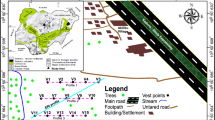Abstract
Groundwater overexploitation where fresh and saline aquifers are adjacent to each other increases saline water hydraulic gradient, and salinity moves toward fresh aquifer which intensifies salinity in shallow aquifers. In Qazvin plain located in the northwest of Iran, salinity is expanding under this mechanism. The purpose of this study is to assess the effect of constructing an interceptor drain as a structural solution in controlling salinity expansion. By means of HYDRUS-2D, the presence and absence of drain were simulated in 5-, 10-, 15-, and 20-year periods. Results have shown that in different distances and depths, interceptor drain can control salinity both in short and long terms. Twenty years after the construction, primary salinity in presence of the drain has increased by 59.5% and 89.5% at 50 m and 150 m on the left side respectively due to solute movement toward the drain, while in the absence of the drain, salinity has increased by 250.5% and 275.2% in the same place due to inverse gradient. At 50 m and 150 m on the right side of the drain, primary salinity has increased by 43.8% and 51.9% and 55% and 173.3% in the presence and absence of the drain, respectively. Also, in drain’s presence, primary salinity has decreased by 16.1%, 15.2%, and 13.8% at 3 m, 5 m, and 7 m respectively while in drain’s absence, salinity has increased by 203.2%, 197.1%, and 133.8% at the same depths, respectively. Thus, interceptor drain is an effective solution for controlling salinity in areas under the same conditions. Also, as the distance from drain increases, its effect decreases.







Similar content being viewed by others
Data availability
The data that support the findings of this study are available from the corresponding author, upon reasonable request.
Notes
Max error
Normalized root mean square error
R-square
Coefficient of residual mass
References
Abbasi F, Tajik F 2007 Estimation of Soil hydraulic and solute transport parameters from transient field experiments using inverse modeling. J Water Soil Sci 11(1): 111–123.in Farsi. 10.1001.1.24763594.1386.11.1.9.1
Amin Salehi A, Navabian M, Varaki ME, Pirmoradian N (2017) Evaluation of HYDRUS-2D model to simulate the loss of nitrate in subsurface controlled drainage in a physical model scale of paddy fields. Paddy Water Environ 15(2):433–442. https://doi.org/10.1007/s10333-016-0561-z
Badaruddin S, Werner A, Morgan L (2015) Water table salinization due to seawater intrusion. Adv Earth Space 51(10):8397–8408. https://doi.org/10.1002/2015WR017098
Ebrahimian H et al (2012) Comparison of one- and two-dimensional models to simulate alternate and conventional furrow fertigation. J Irrig Drain Eng 138(10):929–938. https://doi.org/10.1061/(ASCE)IR.1943-4774.0000482
El-Naqa A, Al-Momani M, Kilani S, Hammouri N (2007) Groundwater deterioration of shallow groundwater aquifers due to overexploitation in northeast Jordan. Clean: Soil, Air, Water 35(2):156–166. https://doi.org/10.1002/clen.200700012
FAO soils portal (2020) Extent of salt affected soils
Ghorbani K, Lee T, Wayayok A, Boroomandnasab S (2016) Interceptor drainage modeling to manage high groundwater table on the Abyek Plain, Iran. Irrig Drain 65(1):341–359. https://doi.org/10.1002/ird.1955
IRCID (Iranian national committee on irrigation and drainage) (2008) Newsletter no 71 .in Farsi
Jaffari M, Sotoodehnia A (2011) Monitoring and modeling of central Qazvin saline drainage drainage to control salinity. Master Thesis, Imam Khomeyni International University.in Farsi
Jafari M, Sotoodehnia A, Daneshkararaste P (2015) Qazvin Interceptor drain rule on controlling salinity. J Soil Water Res 45(4):447–452. https://doi.org/10.22059/ijswr.2014.52597. (in Farsi)
Javadzadeh F, Khaledian M, Navabian M, Shahinrokhsar P (2017) Simulations of both soil water content and salinity under tape drip irrigation with different salinity levels of water. Geosystem Engineering 20(4):231–236. https://doi.org/10.1080/12269328.2017.1298478
Pophare A, Lamsoge B, Katapatal Y, Nawale V (2014) Impact of over-exploitation on groundwater quality: a case study from WR-2 Watershed India. J Earth Syst Sci 123(7):1541–1566 (https://www.ias.ac.in/article/fulltext/jess/123/07/1541-1566)
Rahman Sh, Rakibhasansharker M, Younusmia M (2017) Spatial and temporal variation of soil and water salinity in the south-western and south-central coastal region of Bangladesh. Irrig Drain 66(5):854–871. https://doi.org/10.1002/ird.2149
Simunek J, Sejna M, van Genuchten M (2011) User manual. SpringerReference: 322
Acknowledgements
This work supported by the Biotechnology Development Council of Iran (Grant No. 00/15310). Also the authors would like to thank Imam Khomeini International University for giving us access to second version of HYDRUS-2D and dedicated license.
Author information
Authors and Affiliations
Corresponding author
Ethics declarations
Conflict of Interest
The authors declare no conflict of interest.
Additional information
Responsible Editor: Broder J. Merkel
Rights and permissions
Springer Nature or its licensor (e.g. a society or other partner) holds exclusive rights to this article under a publishing agreement with the author(s) or other rightsholder(s); author self-archiving of the accepted manuscript version of this article is solely governed by the terms of such publishing agreement and applicable law.
About this article
Cite this article
Latifi, M., Etedali, H.R. & Soltani, M. Assessing the effect of an interceptor drain in controlling soil salinization expansion using HYDRUS-2D. Arab J Geosci 16, 192 (2023). https://doi.org/10.1007/s12517-023-11279-3
Received:
Accepted:
Published:
DOI: https://doi.org/10.1007/s12517-023-11279-3




